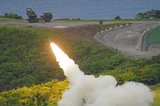Curtain rises on ACT-IV
Northrop Grumman tests ACT-IV for the AFRL and DARPA at the company radar range in Linthicum, Maryland. (Photo: Northrop Grumman).
Northrop Grumman announced on 31 August that it has delivered the Arrays at Commercial Timescales Integration and Validation (ACT-IV) system to DARPA and the US Air Force Research Laboratory (AFRL).
The multifunction digital AESA system completed multiple successful demonstrations and acceptance testing at a Northrop Grumman radar range.
By applying the flexibility of digital AESA, ACT-IV can perform radar, EW and communication functions simultaneously by controlling a large number of independent digital transmit/receive channels.
Development of ACT-IV marks a ‘breakthrough in AESA performance’ and ‘an important milestone in the nation’s transition to digitally reprogrammable multifunction radio frequency (RF) systems’, said William Phillips, director of multifunction systems at Northrop Grumman.
He added that capabilities in the new system ‘will be used to enhance the next generation of integrated circuits and AESAs that are currently in our digital AESA product pipeline’.
|
More from Defence Notes
-
![Taiwan approved for purchase of $11 billion in weapons from US]()
Taiwan approved for purchase of $11 billion in weapons from US
The US State Department’s approval of a multi-billion-dollar sale of weapons to Taiwan includes tactical mission networks equipment, uncrewed aerial systems, artillery rocket systems and self-propelled howitzers as well as anti-tank guided missiles.
-
![US National Security Strategy prioritises advanced military capabilities and national industry]()
US National Security Strategy prioritises advanced military capabilities and national industry
The 2025 NSS has emphasised investment in the US nuclear and air defence inventory and national industry, but it leaves multiple unanswered questions on how the White House will implement this approach.
-
![Canada set to look away from its neighbour and across the Atlantic for partners]()
Canada set to look away from its neighbour and across the Atlantic for partners
While non-EU UK struggles to join the Security Action for Europe initiative, which provides loans for defence programmes, Canada has become the first country outside Europe to get access – and did so for a nominal fee.
-
![NATO experiments with solutions to integrate networks, AI and uncrewed systems]()
NATO experiments with solutions to integrate networks, AI and uncrewed systems
During the latest edition of the NATO DiBaX, the alliance tested multiple capabilities to inform requirements for future efforts.
























